
Cauterizing Procedure Page Menu: 1 2 3 4 5 6 7 8 Next>>
Cauterizing Procedure During the Golden Age of Piracy, Page 6
Potential Cautery Procedure
Most period authors do not give a detailed description of how to apply a potential or chemical cauterizing agent, perhaps thinking it was better learned by practical experience. However, in his surgical textbook, French surgical teacher Pierre Dionis provides a very detailed, step-by-step procedure for using cauterizing stones, complete with line diagrams of the components used.
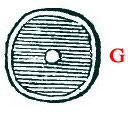
Cautery Plaster G -
From
Cours d'Operation by
Pierre
Dionis, Table
LVI,
page
835 (1740)
Dionis begins by preparing a covering to protect the surrounding skin. He directs his students to cut a "little round Plaister G, of the size of a Crown-piece, and provided with a Hole in the middle; we cover it with a very emplastic [adhesive] Unguent, that it may stick fast to the Skin, and hinder the Scar [from] becoming larger than the Hole in the middle of the mention’d Plaister, which is to be proportioned to the Dimensions of the Cautery which we design to lay on. We lay this Plaister on the Place defin’d to the Cautery, taking care that it be well placed."1
In the diagram, the emplastic Unguent is shown as horizontal lines on the plaster. The plaster itself would probably be cut from lint or a similar substance.
Once the plaster is located and secured on the patient,
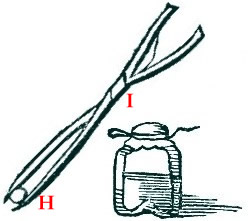
Cautery Pincers I and Stone H with Bottle - From
Cours d'Operation by Pierre Dionis, Table LVI,
page 835 (1740)
Dionis specifies the use of the cauterizing stone.
As soon as the Plaister is laid on its place, we open the bottle of Caustics, in order to take out the Stone H, which we both draw out, and lay on with the Pincers I: Before we lay it on, we wet the Skin with a drop of Water, to facilitate the dissolution of the Stone, that it may the sooner take Effect. [This is where the plaster G is important - once dissolved, the more fluid cauterizing agent would be difficult to control without some kind of border to keep it in place.]
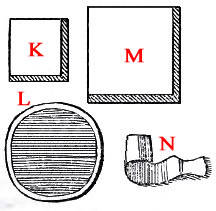
Cautery Bandages & Bolsters - From Cours
d'Operation by Pierre Dionis, Table LVI,
page 835 (1740)
Over it we lay the little Bolster K, shap’d square, and wetted for the same end, this we cover with the large Plaister L, and afterwards with the Bolster M, and over that fix a circular Bandage with the Band N, which we draw somewhat tight, that it may rest on the caustic Stone, and hinder the Apparatus from shifting its Place.2
This last step is performed to keep the the cauterizing agent in place while it works on the skin beneath it. Unlike actual cauteries, which worked quickly, potential or chemical cauteries took longer to eat away the skin and would have to be left on the body for a period of time. Thus the need for all the bandages and plasters.
Dionis doesn't leave the surgeon there, explaining that the surgeon should be familiar with how the type of caustic medicine he applied works and this should guide him in how long to leave it on. This is apparently something that was learned by experience because he doesn't give any detail on different types of cautery agents. He does advise the surgeon to "avoid the Inconveniencies of taking it off before the it has formed its Scar, and consequently save the Trouble of coming again two Hours after, or of laying on another [caustic agent], as it sometimes happens; Nor are we to leave it on too long; for if the [caustic] Stone be good, it may in a Child or Woman, whose Skin is most tender, have cut too deep, it acting more or less, according as the Skin which it attacks is more or less tender."3
Dionis continues his instructions once the caustic has done its work:
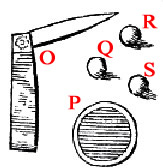
Cautery Lancet, Linen & Stopples
Cours d'Operation by Pierre
Dionis, Table LVI, page 835
(1740)
If we find the Scar well, we take off all the Apparatus, and with the Lancet O make two small Incisions cross-ways in the Body of the Scar; on which we lay the little bit of Linen P, cover’d with a little Basilicon [Unguentum Basilicon - containing oils, resin & lard among other things] or fresh Butter [to relieve the pain in the burn], and over that lay the same Bolster and Bandage.
We continue the same Remedy until the Scar falls off, when we put into the Hole the great Pea Q, or a round Stopple made of Iris-Root R. Some content themselves with cutting in a little waxen Ball S; but the Peas and Iris-Root are better, because they imbibe the Humidities of the Cautery, and we take them out always bigger than we put them in, which keeps the Orifice of the Ulcer [open], which inclines to contract and fill up in a just Magnitude.
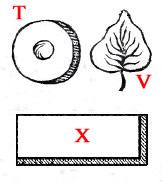
Cautery Linen, Bolster & Leaf
Cours d'Operation by Pierre Dionis,
Table LVI, page 835 (1740)
We then lay on a little bit of white Linen with a Hole at the Place of the Pea T, and over than an Ivy-Leaf V, which is said to be particularly efficacious to procure a regular Suppuration [formation of pus]: We end then with Bolster X, and the same Bandage as the precedent Day.
We are to take care to dress these Cauteries or Issues twice each Day, and to make use of Linen whitned with Lye, if we would avoid an ill Scent; and if the Flesh grows too much, and transcends the edge of the Issue, it must be consum’d with pulverised burnt Allum.4
The detail about an ivy leaf is interesting as a way to encourage the formation of pus to encourage the bad humors to leave the wound. It may not have been widely used on a ship because all the ivy leaves would be dried out within a few weeks of leaving port. Then again, Dionis does not say whether or not a dried leaf could be used.
1 Pierre Dionis, A course of chirurgical operations: demonstrated in the royal garden at Paris. 2nd ed., p. 468; 2 Dionis, p. 468-9; 3,4 Dionis, p. 469
Potential (and Actual) Cauteries For Teeth

Artist: Theodor Rombouts
The Tooth Extractor
(1635)
"But if the tooth bee hollowed, and that the patient will not have it pull'd out, there is no speedier remedie, then to put in caustick medicines, as oil of vitriol [sulfuric acid], aqua fortis [nitric acid in water], and also a hot iron; for thus the nerv is burn't in sunder, and loseth it's sens." (Ambroise Paré, The Workes of that Famous Chirurgion Ambrose Parey, p.414)
Although there is not a lot of detail on how cauterization was performed on rotting teeth, we do have some information in sea surgeon John Moyle's book that provides a bit of insight.
The potential [cautery to be used on teeth] is Ol. Vitriol [oil of vitriol - sulfuric acid] put into the Tooth on a pellet of Lint; and here must care be taken too, lest it touch the Mouth or Gums. This hath likewise often taken effect.1
Moyle goes on to suggest that if the tooth is still bothering the patient after the potential cautery has been applied, the surgeon should just remove it.
1 John Moyle, The Sea Chirurgeon, p. 242-3
Cautery by Oil Procedure
Cauterizing with hot oil is actually an ancient procedure which does not fully fit any category. It is liquid, like a potential cautery category, but it operates by heat and not by chemical reaction. However, unlike the actual cautery, it is not a red hot iron. So we will feature it in it's own section. Only two of the surgeons under study talk about this procedure. The first is Ambroise Paré. who used it at the beginning
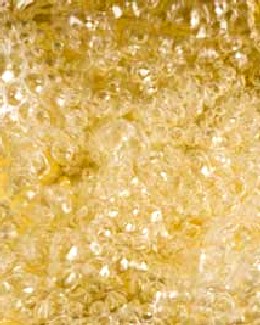
Boiling Oil
of his career until he discovered (at least in gun shot wounds) that treating wounds with medicines instead of cauterizing was more healthy for the patient. The second is sea surgeon James Yonge, who discusses the procedure in regard to amputation, providing even more detail on how hot oil should be used.
Paré refers to John de Vigo [Giovanni da Vigo, a 15th/16th century Italian surgeon] as his source for the idea that bullet wounds had to be cauterized to prevent poisoning. He explains that de Vigo advised the surgeon to "cauterize them [gun shot wounds] with oyle of Elders scalding hot, in which should be mingled a little Treackle [or Theriac - a complex herbal concoction used to counteract poisons] ...I was willing to know first, before I applied it, how the other Chirurgions did for [applied] the first dressing, which was to apply the sayd oyle the hottest that was possible into the wounds, with tents [rolls of absorbent material, often medicated to keep a wound open] and setons [material such as thread, wire, or gauze that intended to form a way for pus to escape]; insomuch that I tooke courage to doe as they did"1.
Ever concerned for the patient's welfare, Paré warns in another place that when "pouring on of which [oils] I would have the Surgeon to bee prudent and industrious, lest he should rashly violate the neighboring sound parts by the burning touch of these things; which his temeritie would caus vehement pains, inflammations, and other horrid symptoms."2 Of course, he learned from inadvertant experimentation that hot oil cauteries often did more harm that good and wrote his famous treatise advocating against this procedure.
James Yonge gives a more descriptive explanation of how he uses hot oil cauteries when amputating.
And first, I must not forget to tell you, that it ought to be very hot, and more, or less so, according to the urgency of the flux, the temper of the Patient, the quickness or flatness of the Spirits, and native heat of the part; and because in heating it, it is very apt to flame, and when so, is difficultly extinguished. I always in Amputations or large Wounds, have two Vessels with the Oil in them, ready heated; that if one kindle [catch fire], the other may serve. I do also heat it on glowing coals, that have no flame, and in a broad deep Vessel, that may sufficiently intercept the force of the fire, from kindling the exhaling spirits.3
Just as he did for heating cauteries, Yonge addresses the problem of heating oil during sea battles
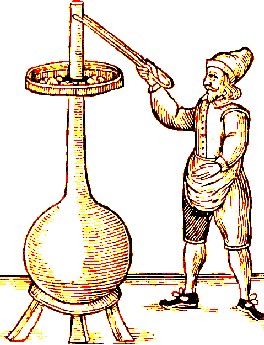
A Matrass or Boltshead from The art of distillation,
by John French, p. 8 (1651)
where "partly from the hazard and inconvenience of fire; partly from the tediousness of heating it" warming the oil for cauterization could be very dangerous.4
I have considered of a very effectual way: which is to have a Copper Vessel, with a long neck, flat bottom, and a narrow mouth, like a chymical Matrass, or Bolts-head [a type of flask - see a very large example at right], to which I would have, either a close stopper, or a Cover, so exactly fitted, that the spirituous parts of the Oil should not by continual heat evaporate away; this would be kept in due heat by a very little fire, not more than is necessary to heat Cauterizers, and without and danger of flaming; nor would its continuance on the fire, rebate its vertue; for by the Vessels being closed, as I have said, the Spirits and evaporative parts, would only circulate therein.
Some few of the more volatile would be spent upon every opening it, which however might not be inconvenient, since by discharge, the medicine is not so potentially hot, and thereby fitter for recent simple Wounds: by this means having it always ready, it's but to pour a necessary quantity into a Porringer or other convenient Vessel, at the time you are ready to use it: the different particular ways of which I forbear here to recite, because in the Histories or Observations, they will be sufficiently related.5
1 Ambroise Paré, The Apologie and Treatise of Ambroise Paré, p. 23; 2 Ambroise Paré, The Workes of that Famous Chirurgion Ambrose Parey, p. 485; 3 James Yonge, Currus Triumpalis, é Terebinthô., p. 51; 4 Yonge, p. 51-2; 5 Yonge, p. 52

